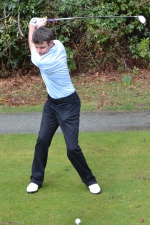Neuro Linguistic Programmimg
NLP explores the relationship between how we think (neuro), how we communicate (linguistic) and our patterns of behaviour (programmes). By doing so people can think, communicate and manage themselves more effectively. I use my NLP training for golf to help my pupils replace negative behaviours and habits with positive ones.
I use simple drills such as
Visualisation – Visualising good results before executing a shot will put the player into a positive, focused mindset.
Goal-Setting – Particularly useful when trying to produce a program for improvement. Goal setting will help prioritise which areas of a golfer’s game to focus on.
Routines (pre-shot and post-shot) – Sound routines will help the player to prepare for a shot. When asked how he coped with the immense pressure during the last round of his Open victory Darren Clarke replied 'routine, routine, routine'.
Re-Framing – The ability to re-frame your thoughts during pressurised situations is invaluable. e.g. view a tough match against a good opponent as an exciting opportunity to make an exceptional achievement rather than a hard task.
Breathing Techniques – Will help you to stay calm under pressure. Tiger Woods has used these techniques since he was a child helping him to become an excellent performer under the most severe pressure.
Body Language – This technique is very simple but very effective. Simple things like keeping your head and eyes up and walking with your shoulders back will make you feel upbeat. Think of Ian Poulter, an extremely positive character, this is exactly how he walks.
Self-Talk – Positive self-talk can be used as a tool to maintain and boost confidence levels. A few positive sentences at the right time during a round can remind the player what they are capable of. Unfortunately most golfers do the opposite.
Good Shot Log – Another simple but effective idea to keep confidence high. Simply keep a diary of good shots that you hit. Following every round add 3 good shots that you have hit. Describe them in as much detail as possible so that when you read the diary you will feel like you are hitting the shot again. Tour professionals including Paul Casey and Phil Mickleson use this technique.


